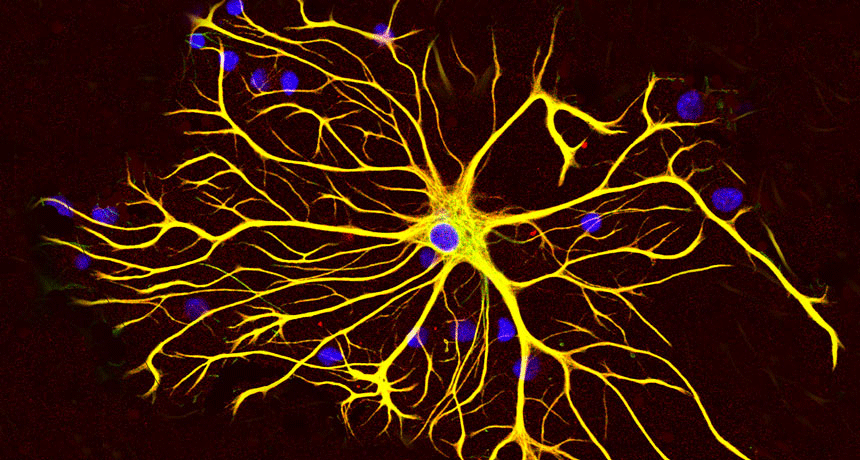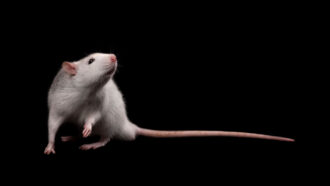Ow! These cells might help brains remember pain and fear
Called astrocytes, they send out a signal to teach a painful lesson

This glowing yellow web is a single astrocyte — a support cell in the brain. But these cells may play another role by helping the brain process painful experiences.
GERRYSHAW/WIKIMEDIA COMMONS (CC BY-SA 3.0)
WASHINGTON, D.C — War, pain and other traumatic events can sear themselves into our memories. Now, a study in rats offers clues to how the brain appears to form those memories. It gets a hand from cells called astrocytes. Scientists used to think these cells only provided food and comfort to more important nerve cells. It now turns out that astrocytes may play a key role in how we learn from tough times.
Fear and pain are not pleasant. But they can help us to learn how to anticipate it — or avoid what triggers it — in the future. That’s a benefit. But when an event is truly terrible, such memories can become a source of post-traumatic stress disorder, or PTSD.
This is a severe condition that can occur after someone has a terrible experience, such as a terrorist attack, kidnapping or battlefield firefight. People with PTSD may become anxious, even when there’s no danger. They also may have flashbacks, where they remember a traumatic event, replaying the details over and over in their mind.
Meghan Jones is a brain scientist at the University of North Carolina in Chapel Hill. She wants to know where fear crosses the line from learning to trauma. It’s difficult to study memory or PTSD in people. After all, everyone’s experience is different. So Jones and her colleagues work in rats.
To make sure their animals had a powerful bad memory, the scientists gave these rats a short series of foot shocks. These did not injure the animals. Indeed, Jones tested the shocks on herself. They were painful and scary, she recalls — “painful enough to make you curse.”
Rats are no fools when it comes to fear. A week after the first, painful experience, they remained jumpy when given a second, milder shock (about as strong as the static-electricity shock one might get from a metal doorknob in winter).
The point of the research was not to make rats miserable. Jones and her team wanted to figure out what was going on in their brains. To do this, the scientists focused on the hippocampus. It’s an area of the brain important for learning and memory.
After the first painful experience, the rat’s hippocampus released a chemical called interleukin 1 beta (IL-1 beta). This chemical is important in inflammation — or how the body responds to stress or injury.
More than 90 percent of this IL-1 beta was coming from astrocytes, the researchers found. And this surprised them.
Not just support
Scientists used to think of astrocytes and other non-nerve cells in the brain as mere support cells. They did the dirty work, cleaning up messes and providing food to the neurons — nerve cells that are the stars of the nervous system and that conduct electrical signals. Astrocytes were just the backup dancers. But now, it appears astrocytes have their own important roles to play.
The scientists treated the animals’ brains with a drug designed to turn on a signal in their brains’ astrocyte cells. That signal was inhibitory — meaning that it reduced the activity of the astrocytes. With this treatment, the scientist were able to change how the rats learned fear. Instead of getting jumpy, the animals stayed calm in the face of later shocks.
This could mean the animals need IL-1 beta from the astrocytes to remember scary times. Jones and her group haven’t specifically figured out how IL-1 beta from astrocytes does this. But they are running more tests to find out.
On November 15, they presented their initial results here at the annual meeting of the Society for Neuroscience.
Rebecca Shansky is a brain researcher at Northeastern University in Boston, Mass. She says the rat tests may offer only a rough gauge of what to expect in people with PTSD. Why? The rats here were tested only one week after they went through their painful experience. People, in contrast, don’t get diagnosed with PTSD until at least a month has passed since their trauma.
But the study does show how animals learn and make memories from stressful experiences. As such, Shansky notes, “it’s pretty cool.” What’s more, she says, “The idea that there are inflammatory mechanisms involved in the way these experiences are processed makes sense.”
Where those inflammatory signals come from is important, notes Georgia Hodes. She’s a brain scientist at Virginia Tech in Blacksburg. “Everyone’s been focused on what neurons are doing,” she says. This is “showing an important effect of cells we thought of as only being supportive.”
Studies like these are “changing how we think about the circuitry that’s involved in depression and post-traumatic stress disorder,” Hodes says. Understanding more about how memories form could eventually help scientists find the line between PTSD and helpful — if painful — memories.







